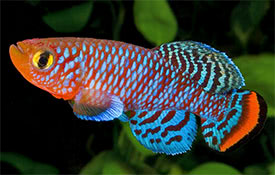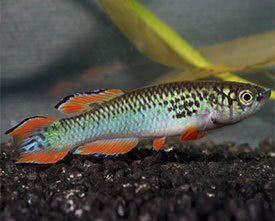
 Magyarul / Hungarian
Magyarul / Hungarian
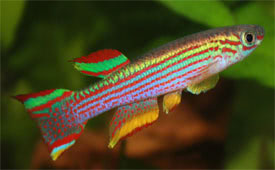
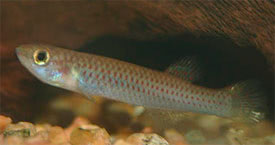
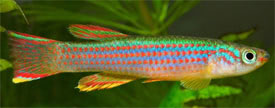
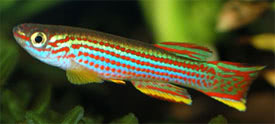
- Scientific name: Aphyosemion striatum
- Synonyms: Epiplatys striatus, Haplochilus striatus, Panchax striatus
- Common name: Red-Striped Killifish, Five-Banded Killifish
- Group: Killifish
- Habitat: Africa; Gabon and Equatorial Guinea
- Size: 5-6 cm
- Biotope: Inhabits in small, shallow coastal rainforest streams and swamps.
- Social behavior: A very peaceful and shy fish. Can be kept in a community tank with small characins and rasboras. Keep in mind, that they will easily be outcompeted by more vigorous fish.
- Diet: Omnivorous; They will eat small live and frozen foods, also good quality flake foods.
- Breeding: Quite easy
- Tank: Minimum 30 litres
- Population: 1 male and 2-3 females for 40 litres
- Decoration: Use dark substrate (peat), and plant the tank densely, with a cover of floating plants to diffuse the light. The fish is an excellent jumper so the cover must be very tight fitting. Provide hiding places with wood and roots.
- Temperature: 20-23 °C
- pH: 5,5-7
- Hardness: 3-12 NK°
- Lifespan: 3-5 years
Description: Red-Striped Killifish is an elongated fish with an up-turned mouth. The back is brownish orange. The flanks are blue or turquoise with five, red, lateral dotted line. The dorsal fin is green with two red stripes. The caudal fin is marked with red spots and stripes. The lower edge of the caudal, anal, and pectoral fins are yellow. Red-Striped Killifish is a good beginner killifish as they are beautiful, easy to breed and relatively long-lived. At higher temperatures, Aphyosemion striatum will lose some colors and live for shorter periods.
The male is the larger, more brightly colored fish with longer caudal, dorsal and anal fins. Aphyosemion striatum can be bred in small tanks (12 litres) without lighting with an air-driven sponge filter to prevent stagnation. Water should be soft and acidic (pH 6.0-6.5) with a temperature of 20-22 °C. The sexes should be kept separated before spawning and conditioned on a varied diet of live and frozen foods. Select the most colorful male and the plumpest female and put them in the breeding tank. The female will deposit her eggs in the substrate or attached them to plants, so the spawning medium can either be a layer of peat moss or large clumps of Java Moss or spawning mops. A pair in top condition may spawn 20-30 eggs daily for a period of about 2 weeks. Each pair should only be allowed to spawn for a week as they become weak during spawning (especially the female). Collect the eggs regularly. The eggs can be incubated in water or by placing them on a layer of peat moss. Either way the eggs should be kept in darkness, as they are very sensitive to light. If incubating in water, transfer them into a rearing container where they will hatch after about 10-14 days. When peat fibers are used, they can be removed and stored moist in a plastic bag for 18 days, then hatching can be induced by simply placing the eggs into the water. The tiny fry can be fed with infusoria in the first days. After about 2 days the fry can be fed with small Brine Shrimp nauplii. The fry should initially be kept in very shallow water but the level can be raised as the fry grow.









